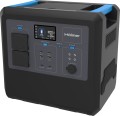Add to comparison |  |  |
|---|---|---|
| HOLMER BCP2400 | 2E Syayvo 2E-PPS24256 | |
| Expecting restock | Outdated Product | |
| TOP sellers | ||
Parallel connection of up to 2 charging stations. | ||
| In box | charging station | charging station |
| Rated power | 2400 W | 2400 W |
| Peak power | 3000 W | |
| Output waveform | sinusoid (PSW) | sinusoid (PSW) |
| UPS function | ||
Outputs | ||
| Sockets (230 V) | 2 | 2 |
| USB A (quick charge) | 4 5В/3A, 9В/2A, 12В/1.5A 18 W | 4 5В/3A, 9В/2A, 12В/1.5A 18 W |
| USB C | 2 pcs 3 A, 5 A 100 W | 2 pcs 3 A, 5 A 100 W |
| Car cigarette lighter | ||
| DC output | 4 pcs (12 H / 10 A) | |
Inputs (station charging) | ||
| From solar panels | ||
| Input port XT60 | ||
| Add. ports | AC extension port | |
Battery and charging time | ||
| Connecting an additional battery | ||
| Battery type | LiFePO4 | LiFePO4 |
| Battery capacity | 2560 W*h | 2560 W*h |
| Charging cycles | 2000 | 2000 |
| Charging power (socket) | 2000 W | 2000 W |
| Charging power (solar panel) | 400 W | 400 W |
General | ||
| Smartphone synchronization | Bluetooth and WiFi | Bluetooth and WiFi |
| PSU | built into the body | |
| Display | ||
| Backlight | ||
| Carrying handle | ||
| Operating temperature | -10 °C ~ +45 °C | -10 °C ~ +40 °C |
| Dimensions | 374x265x345 mm | 374x265x345 mm |
| Weight | 26 kg | 26 kg |
| Added to E-Catalog | december 2024 | december 2023 |
Charging stations HOLMER BCP2400 and 2E Syayvo 2E-PPS24256 have similar characteristics, both with a nominal power of 2400 W and support a sine wave output (PSW). However, 2E Syayvo offers a peak power of 3000 W and UPS functionality, which may be important for users needing backup power. Both devices have the same battery capacity of 50 Ah and a LiFePO4 battery type, but the HOLMER BCP2400 supports connecting additional batteries. In terms of connectivity, both models have 2 outlets and 4 USB ports, but 2E Syayvo allows parallel connection of up to two stations, increasing usage flexibility. The operating temperature range for HOLMER is -10 °C to +45 °C, whereas for 2E Syayvo, it is -10 °C to +40 °C. Both devices have similar dimensions and weight, making them convenient to carry. Overall, the choice between them will depend on the user's specific needs, such as the need for a UPS or parallel connection.